Fishing Report: December 3, 2021

You'll find big catches of gag grouper offshore
Gag grouper action is going extremely well offshore right now on our long-range trips. During a previous long-range trip at Hubbard's Marina, anglers caught more than 90, says Captain Dylan Hubbard.
MADEIRA BEACH, Fla. - Every Friday morning, Captain Dylan Hubbard of Hubbard's Marina joins Good Day to fill viewers in on his fishing forecast as we head into the weekend.
Here is his fishing report for December 3, 2021.
Inshore
We can expect a new moon this weekend with a low approaching the area in the early part of the workweek. These two things coupled together should bring us good water movement and a hot bite over the weekend and into the start of the coming week.
It’s a wonderful time to get out on the water and take advantage of the good fishing we are seeing around the area. Plus, later in the week, that little front should keep fish moving and getting more into that ‘wintertime’ pattern around our area.
Redfish action has been great around our area this past week, and this should continue around our grass flats, oyster bars, and mangrove shorelines. Plus, we’re seeing some of these fish start to move to those residential dock lines too.
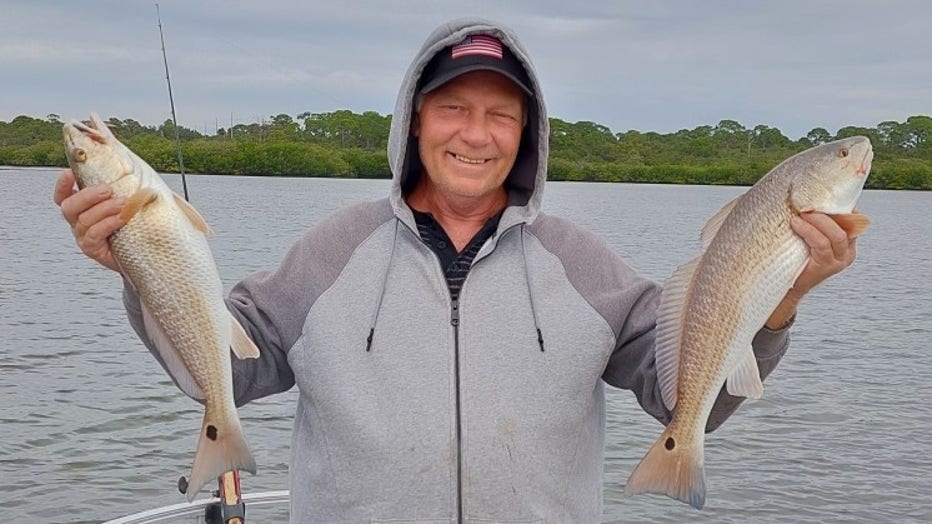
Redfish (Credit: Hubbard's Marina)
Passes around the area are still holding some nice numbers of redfish too on the sandy bottom areas, around bridge lights or dock lights at night, and through the day around or adjacent to the structures. Live shrimp becomes more the bait of choice for these guys as bait gets more and more scarce. Plus, the redfish love crustaceans like shrimp and smaller crabs. Also, small pinfish work well for redfish too and even cut dead bait especially as water temps fall.
Sheepshead fishing is going extremely well around our local dock lines, bridges, canals, oyster bars, jetties, and piers. Virtually any structure with growth, like even mangrove shorelines, will be home to some hungry sheepshead.
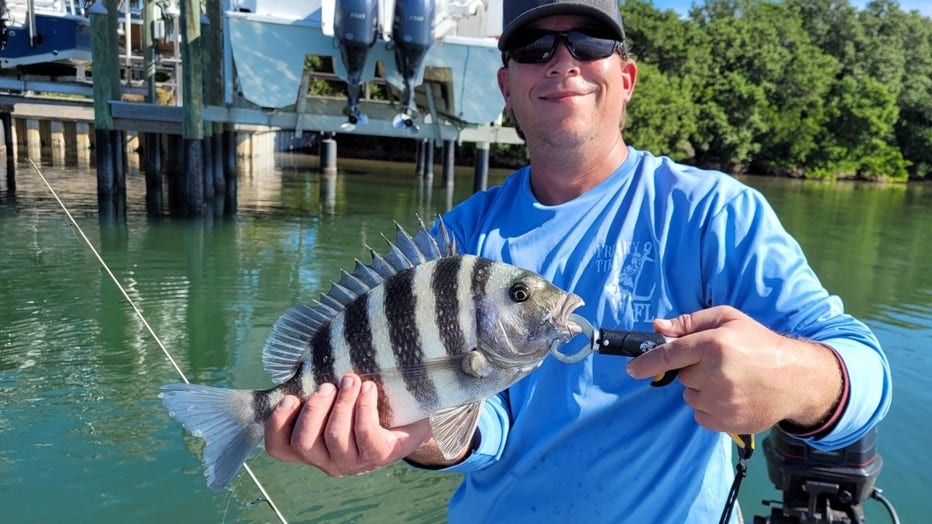
Sheepshead (Credit: Hubbard's Marina)
Smaller hooks, tackle, and minimal weights with small chunks of shrimp, cut oysters, or clams are a great option for sheepshead. Fiddler crabs and barnacles work well too.
Look for them in areas where waters are moving a little more slowly and you can even start on a slack or slow tide and scrape some barnacles and oysters off the surrounding pilings to get the sheepshead chummed up.
Snook action has slowed a bit around the passes, but the back bay areas are still going well, and we are seeing more action in shallower warmer water areas. In the passes and around those deeper areas, you have to wait until the right time to get those fish in a feeding mentality. We are seeing the snook around dock lights and bridge lights at night where water is pushing unsuspecting baitfish past the structures hiding the big predatory fish.
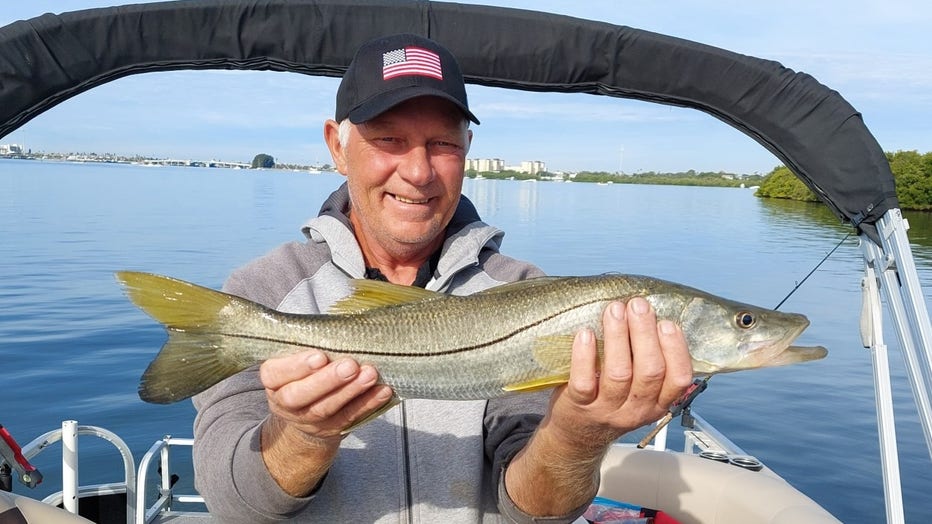
Snook (Credit: Hubbard's Marina)
Trout action is steady around the area, and you can find areas where they are feeding well, but they are a little trickier as of late. We are seeing and hearing about the best action in the early morning or early part of the day before boat traffic picks up and starts to make them more skittish and leader shy.
Also, look for them more in the backwater areas that are less disturbed. At night, you can find them around the dock lights of the area.
Triple tail are still incredibly thick around the area in the bays, passes and along the beaches, if you can find floating debris, markers, or buoys holding these unique-looking fish. They are harder to find in the large keeper-size, but you can get lucky, especially along the beach working those crab trap buoy lines. Using live shrimp or soft plastics are great ways to sight fish these guys.
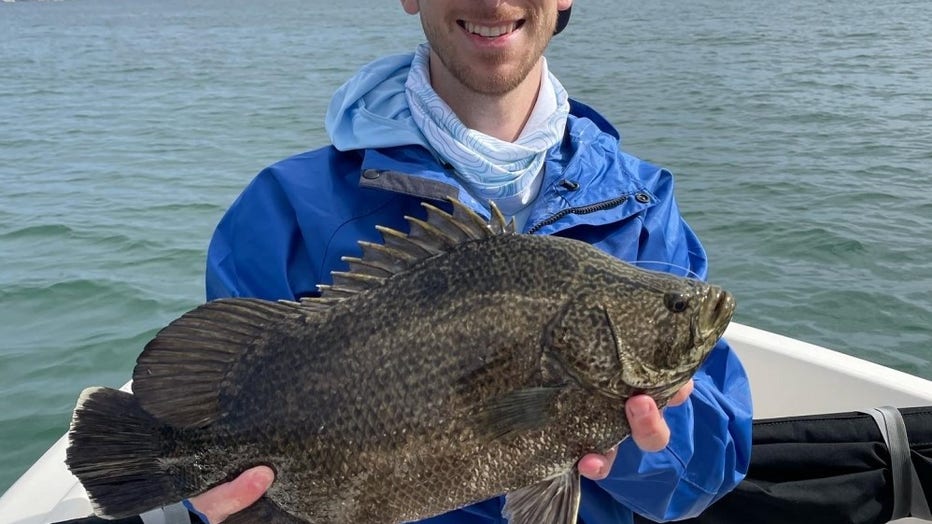
Triple tail (Credit: Hubbard's Marina)
Pompano action is going well around our beaches, sandy passes, and around some select bridges in the area. They like cleaner, clear water areas, and they hunt the sandy bottom for crustaceans. You can even find them around the sandy patches or bars near the grass flats of the bay too.
Flounder are hiding around those sandy patches, cuts, and potholes around our local grass flats. We are seeing them around the local structures, hiding on the sandy bottom areas, waiting for bait to get pushed off structures.
We see them often around our local passes this time of year as they head offshore for their spawn adjacent to the near shore wrecks and reefs. Shrimp, mud minnows, and smaller pinfish are great options for these guys.
Near shore
Hogfish action is now in full swing near shore, and we are seeing some monster hogfish action around 40-70 feet of water near shore right now on live shrimp. It’s an exciting time to get out there and target some of these great eating fish with lighter tackle, lighter lead, and about a 3-4ot hook with around 30lb braid and 30lb floro top shot.
We see most using around 1-2oz of lead and a live shrimp to get the hogfish biting well. We target the smaller ledges, rock piles, and flat hard bottom areas where these guys can cruise just off the bottom, looking for crustaceans along the bottom. However, everything out there bites a shrimp, so you have to wade through a lot of bycatch to find some keeper-sized hogfish while on a near shore trip.
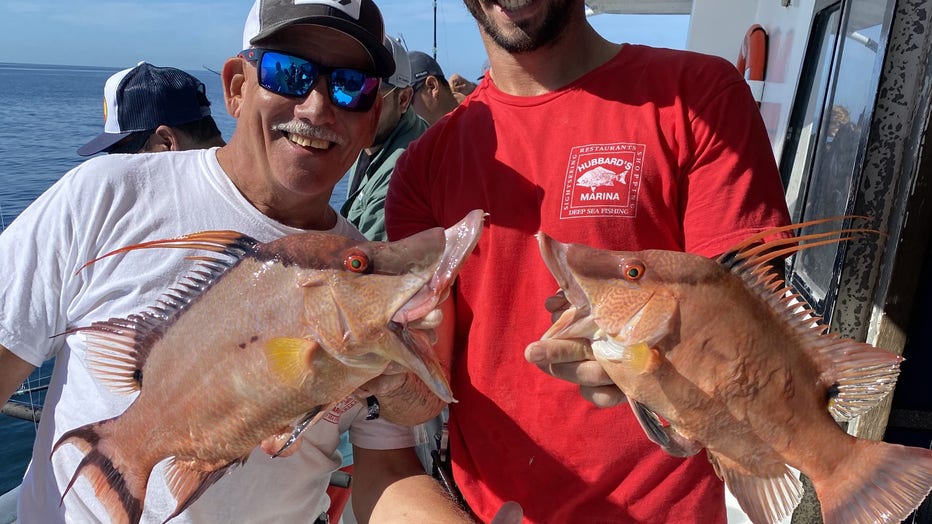
Hogfish (Credit: Hubbard's Marina)
Gag grouper action is starting to pick up more and more near shore in our area. We are seeing a lot of these fish around the 30-100 feet areas near shore. They love live pinfish, pigfish, squirrelfish, and even lizardfish around the ledges, rock piles and sometimes even potholes too.
You can catch ‘em using dead threadfins, sardines, or cigar minnows too, but the live bait is definitely the best bet. Near shore around 60lb test is a great idea but around 80lb is max you can get lucky with less than 60lb but it is hard to land a nice keeper gag on less that 60lb.
Mangrove snapper action is going well near shore, and we are seeing some decent-sized mangroves too. We catch them often while targeting the hogfish with that same hogfish rig and live shrimp.
However, the double snell rig with a small chunk of threadfin will work well too. Around 30lb test leader and 4ot hooks are what you want while targeting these near shore mangrove snapper.
Lane snapper are still biting extremely well near shore and, unfortunately, they are still closed due to the delay in rule-making at the NOAA agency. However, we are hoping to get some news on these guys sometime soon. Luckily, they will open on January 1, regardless.
Kingfish action surprised us this past week near shore. We saw a few nice kings come up on the flat lines on our private fishing charters and party boat fishing trips this past week.
Free lining dead threadfins on a kingfish stinger rig under a balloon worked well from our five-hour party boat fishing trip. The HUB caught one on a private fishing charter free lining a pinfish on the same stinger rig set up too. In order to tie up one of these special kingfish rigs, we do have a great video on this,
Offshore
Gag grouper action is going extremely well offshore right now on our long-range trips.
We are seeing some big catches of gag grouper aboard our 12-hour extreme fishing trips aboard the flying HUB 2 and the 39-hour long-range overnight trip aboard the Florida fisherman. The last 39-hour brought home more than 90 keeper gag grouper using live pinfish and threadfins.
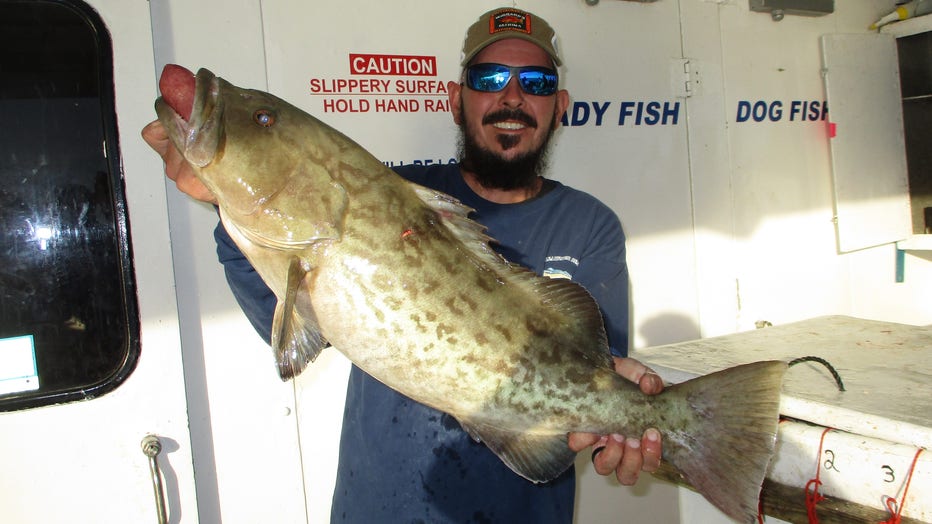
Gag grouper (Credit: Hubbard's Marina)
We had an issue getting a bunch of live baits for this last 39-hour and, despite that, they still had an incredible gag grouper catch. We found that initially landing on a spot, the aggressive gags would bite just about anything including the dead bait.
Then, once on a spot for a bite -- and missing a few fish or rocking some up -- the only thing that seemed to get them going again was the bigger, friskier live baits like pinfish, pigfish, or big squirrelfish. You definitely want a lower gear ratio reel less than 4:1 ratio with at least 80lb mono. You will get more bites using 60lb leader, but you will break off more fish. About 80lb is a good starting point and if the bite is tough you could drop to 60lb.
However, if they are aggressive or if I am dropping a big live bait, I will use 100lb test leader. Around 8-12 ot hooks are common while targeting gags and your hook size will be determined by the size bait you choose.
Mangrove snapper action has been steady offshore with some good-sized mangroves coming up in the 7-9lb range in around 120-180 feet of water. The average-sized fish is still pretty large, and we are seeing them mostly at night, but with those overcast days and especially around this new moon, the daytime mangrove bite will still be steady too.
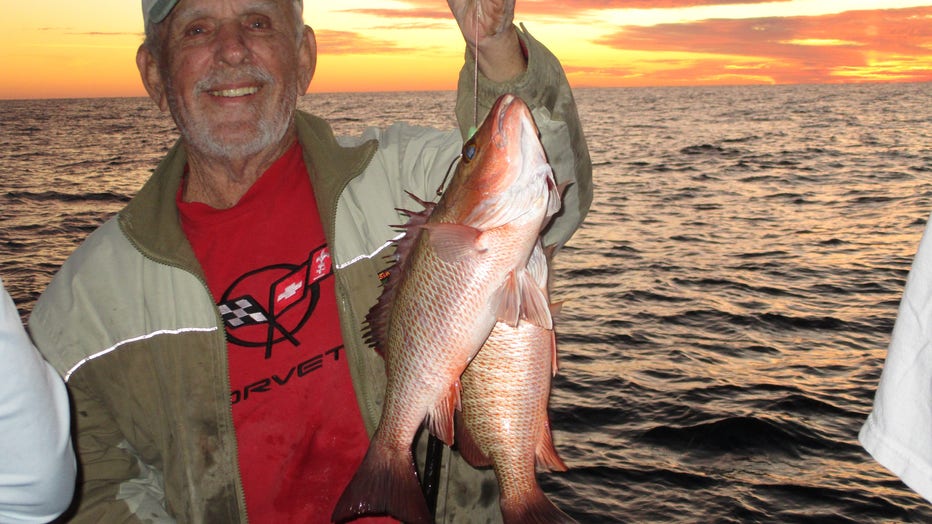
Mangrove snapper (Credit: Hubbard's Marina)
If the fog extends offshore, it makes for a nail-biting ride, but that definitely keeps the mangroves feeding well through the daytime too offshore. This time of year, we often will get the sea fog going when air temperatures are warmer than the surface of the Gulf, which causes thick fog even offshore.
Cubera snapper surprised us this past week with two nice cubera snapper caught offshore fishing for mangroves. Nothing crazy-sized, but we are seeing some of these guys show up which is a little strange as we typically see them at the end of the summer -- around August to September most commonly.

Cubera snapper (Credit: Hubbard's Marina)
Kingfish are still around offshore, and we are seeing some steady blackfin tuna action offshore too. The wahoo may be found as well, but you just never know when trolling what you may run across.
This time of year, while offshore, always keep that pitch rod ready and the flat line out. You may even see a cobia while bottom fishing, but they are very rare off our coast as of late.
Don't be a fool; bring a venting tool and/or a descending device
It is so important to keep in mind the importance of dead discards and discard mortality when engaged in near shore or offshore fishing. If we can all work together to change the cultural norms near shore and offshore, we can all help to improve our fishery and our fishery access overtime.
How many do you know right now that are all for catching and releasing snook, redfish and trout but will be the first in line to kill a mangrove snapper, gag grouper or red snapper and the attitude completely changes when discussing these offshore species?
Plus, the same person inshore that will hold their breath and wet their hands before handling a breeder snook will go offshore and then cull through 20 red snappers before keeper their two red snapper they deem large enough to fill their two fish bag limits while the other 18 they released will often end up suffering fatal damage if not properly descended or vented?
Please help us to spread the word on the importance of descending or venting your released fish. Descending devices are most easy to use and quick to pick up on their use and are most effective for most anglers. However, an expert and precise angler with proper training and tons of experience can use a venting tool properly with similar outcomes. However, a venting tool requires you to pierce the fish while most descending devices are much less invasive.
While using a venting tool it is imperative you pierce them in the exact right spot, and you do not go but a quarter inch or less in the fish. Most venting tools require you to ‘choke up’ on the tool to prevent over penetration into major organs.
When fishing deep water, especially in the sweltering summer months, please make sure to treat all fish intended to be released like that breeder snook inshore and minimize the time it takes you to get him from the bottom to the boat using heavier proper tackle not an ultra-light spinning reel. Then once on board, minimize the time out of the water. Then use a proper dehooking tool, and then for the love of God, use a descending device or venting tool PROPERLY to ensure that fish has a chance to live another day.
Three things will help ensure the survivability of those fish released offshore.
- Making sure they are brought up quickly and do not expend all their energy in the fight.
- Make sure they are unhooked smoothly, easily, and as quickly as possible.
- Finally, make sure they spend the least amount of time at the surface at negative pressures where barotrauma exponentially increases its effect with each passing second.
Also, keep in mind when the water is warm there is less dissolved oxygen content and the chances of barotrauma increase even more while its effects can be even more deadly.
CHECK OUT THE NEW WEBSITE and marketing campaign to get your own FREE descending device and more information on mitigating barotrauma and barotrauma issues! Do not forget to use the hashtag #ReturnEmRight to help spread the word too on fish you catch and release offshore -> https://returnemright.org/
State survey to improve recreational data and access
It is imperative that you have your gulf reef fish survey endorsement on your fishing license if you are a private recreational angler or diver fishing from a private boat anywhere in Florida who intends to harvest, attempt to harvest or possess one or more of the following reef fish species: mutton snapper, yellowtail snapper, hogfish, red snapper, vermilion snapper, gag grouper, red grouper, black grouper, greater amberjack, lesser amberjack, banded rudderfish, almaco jack, gray triggerfish, Gag grouper, Red grouper, Scamp grouper, Mangrove snapper, Lane snapper, Kingfish, Tuna, or Mahi mahi.
Here is all the information and more on that program and how you can sign up -> https://myfwc.com/fishing/saltwater/recreational/state-reef-fish-survey/
TERMS OF REFERENCE:
INSHORE – from the back bays out to the bridges and including right on the beaches
NEAR SHORE – From the beaches out to 20 miles, or up to 100ft of water
OFFSHORE – from 20 miles or 100ft and beyond
For more fishing reports, photos, videos and more check out Hubbard’s Marina on Facebook, Instagram, YouTube, or Snapchat. Just simply search "HubbardsMarina" and do not forget our family motto, "If you’re too busy to go fishing, you’re just too busy!

